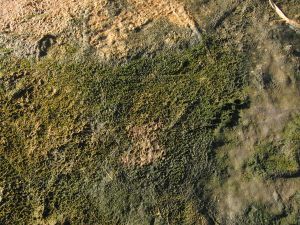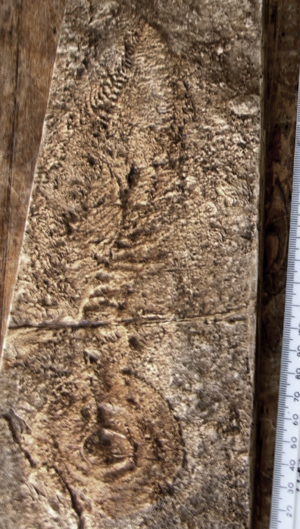كائنات إدياكرا
(تم التحويل من Ediacara biota)
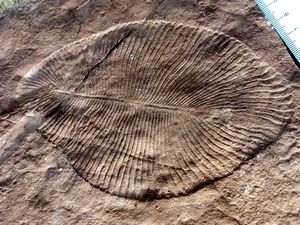
Dickinsonia costata, an iconic Ediacaran organism, displays the characteristic quilted appearance of Ediacaran enigmata.
كائنات إديكارا Ediacara biota، هي مجموعة من الكائنات البحرية عديدة الخلايا، الرخوة اللاهيكلية، التي عاشت خلال المائة مليون سنة الأخيرة من زمان ما قبل الكمبري.[1]
تاريخ
الحفاظ عليها
الجرثومية
Fossilisation
ماهو الحفاظ؟
التشكل
| أشكال حفريات إديكارا | |
|---|---|
| The earliest discovered potential embryo, preserved within an acanthomorphic acritarch. The term 'acritarch' describes a range of unclassified cell-like fossils. | |
| Tateana inflata (= 'Cyclomedusa' radiata) is the attachment disk of an unknown organism. Metric scale. | 
|
| A cast of the quilted Charnia, the first accepted complex Precambrian organism. Charnia was once interpreted as a relative of the sea pens. | 
|
| Spriggina, a possible precursor to the trilobites, may be one of the predators that led to the demise of the Ediacaran fauna[2] and subsequent diversification of animals.[3] | 
|
| A late Ediacaran trace fossil preserved on a bedding plane. | 
|
| A chain of trace fossils created by a grazing Yorgia, terminating with a body fossil of the organism itself (right). | 
|
التصنيف
اللاسعات
"مطلع الحياة الحيوانية"
الشعبة الجديدة
الأشنة
الأصل
الحفاظ على التحيز
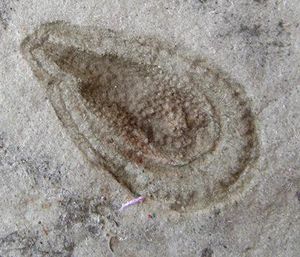
Kimberella may have had a predatory or grazing lifestyle.
الافتراس والرعي
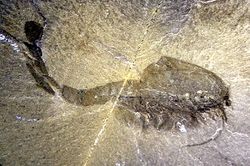
Cambrian animals such as Waptia may have competed with, or fed upon, Ediacaran life-forms.
المنافسة
التغير في الظروف البيئية
التجمعات
تجمع نوع أڤالون
تجمع نوع إديكارا
| Biota ranges[4] | ||
|---|---|---|
| ||
| Axis scale: millions of years ago, dated with U/Pb of zircons |
تجمع نوع ناما
أهمية التجمعات
انظر أيضا
الهوامش
المصادر
- ^ عبد الجليل هويدي، محمد أحمد هيكل (2004). أساسيات الجيولوجيا التاريخية. مكتبة الدار العربية للكتب.
- ^ McMenamin, Mark A.S. (2003). "Spriggina is a Trilobitoid Ecdysozoan" in Seattle Annual Meeting of the GSA. . Retrieved on 2007-06-21.
- ^ e.g. Butterfield, N.J. (2007). "Macroevolution and microecology through deep time". Palaeontology. 50 (1): 41–55. doi:10.1111/j.1475-4983.2006.00613.x.
- ^ خطأ استشهاد: وسم
<ref>غير صحيح؛ لا نص تم توفيره للمراجع المسماةGrazhdankin2004
قراءات للإستزادة
- Mark McMenamin (1998). The Garden of Ediacara: Discovering the First Complex Life. New York: Columbia University Press. pp. 368pp. ISBN 0-231-10558-4. OCLC 37588521 60159576.
{{cite book}}: Check|oclc=value (help) A popular science account of these fossils, with a particular focus on the Namibian fossils. - Derek Briggs & Peter Crowther (Editors) (2001). Palæobiology II: A synthesis. Malden, MA: Blackwell Science. pp. Chapter 1. ISBN 0-632-05147-7. OCLC 43945263 51682981.
{{cite book}}:|author=has generic name (help); Check|oclc=value (help) Excellent further reading for the keen - includes many interesting chapters with macroevolutionary theme.
وصلات خارجية
هذا الملف الصوتي، سـُجـِّل من نسخة بتاريخ 2009-08-29، ولا تعكس التعديلات اللاحقة على المقال. (مساعدة الصوت)
المزيد من المقالات الناطقة
- Ediacara Biota on In Our Time at the BBC. (listen now)
- "The oldest complex animal fossils" – Queen's University, Canada
- "Ediacaran fossils of Canada" – Queen's University, Canada
- "The Ediacaran Assemblage" – Thorough, though slightly out-of-date, description
- "Database of Ediacaran Biota" Advent of Complex Life
